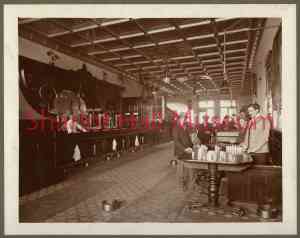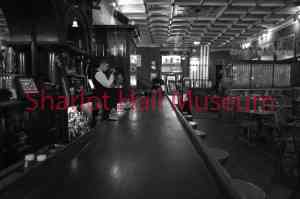By Bradley G. Courtney
In part 1, the question was raised regarding the veracity of the beloved legend of the Palace Saloon’s bar being pulled out to the Plaza and saved during Prescott’s Great Fire of 1900. We left off with the story of how the Palace experienced a fire in its interior in late 1897 and was destroyed only within, including its solid walnut wood bar that had been installed in 1884.
Requirin g only fifty-three days to rebuild, Robert Brow reopened the Palace on December 28, 1897. Some notable changes had been made. Most significantly, a new bar was installed. The Miner’s description of it offers proof that it was the same bar featured in today’s Palace before catastrophe struck the town on July 14, 1900. It stated, “The new bar is one of the handsomest in the south-west. It is made of cherry and is massive in proportions and finished in the most elaborate and artistic style.” That’s a perfect description of the bar that sits in the Palace at this very moment!
g only fifty-three days to rebuild, Robert Brow reopened the Palace on December 28, 1897. Some notable changes had been made. Most significantly, a new bar was installed. The Miner’s description of it offers proof that it was the same bar featured in today’s Palace before catastrophe struck the town on July 14, 1900. It stated, “The new bar is one of the handsomest in the south-west. It is made of cherry and is massive in proportions and finished in the most elaborate and artistic style.” That’s a perfect description of the bar that sits in the Palace at this very moment!
This report and photographic evidence irrefutably prove that it was the same Palace bar being used when the Great Fire of 1900 struck Whiskey Row. It’s plainly seen in the only known pre–Great Fire image of the Palace. Additionally, a section of it is visible in one of the best-known photographs taken shortly after the fire, that of Brow’s temporary makeshift saloon on the Plaza along Montezuma Street.
Another legend developed over the years regarding the Palace bar – that it was shipped from the East and sailed around Cape Horn in South America, then up the Pacific Coast, and finally hauled overland by wagon to Prescott. This would’ve taken at least a half-year. The truth is, it took, at the most, fifty-three days–less than two months–for the bar to be ordered, shipped and installed, but likely in less time than that. It probably came by train from a Brunswick, Balke and Collender store in San Francisco. There was no need for it to come by sea.
The Palace Saloon from 1884 up to July 14, 1900, was, as mentioned in part one, constructed of brick, stone and iron. Hence, it was bypassed for dynamiting during the Great Fire. However, the Palace quickly became another victim of the conflagration. Portions of its walls stood firm, but most of it crumbled to the ground.

Another marvelous story was told twenty-five years after the fire. Firefighter Bob Morrison recalled that the piano from the Palace was also carried out to the Plaza. It was joined by pianist Ed Wilson and a singer described as a “painted lady.” When the piano was situated properly, Wilson started hammering out a popular song of that day, the appropriately inappropriate “There’ll Be a Hot Time in the Old Town Tonight,” while the saloon girl sang heartily, and the fire raged across the street. It caught on and soon many were singing it over and over while the fire burned.
Back to our subject. How was the Palace bar saved? Some say horses were hooked to it and then dragged out to the Plaza. Most likely, it was saved by men with whiskey-fueled courage and an adrenaline rush that often occurs during crises. Interestingly, the story was not reported after the Great Fire or mentioned in newspaper reports written after the many reunions of eyewitnesses of the catastrophe that occurred over the years. So, no one really knows. Whatever way it was achieved, the celebrated bar is still there today and photographed daily by visitors.
.
“Days Past” is a collaborative project of the Sharlot Hall Museum and the Prescott Corral of Westerners International (www.prescottcorral.org). This and other Days Past articles are also available at www.archives.sharlothallmuseum.org/articles/days-past-articles/1 The public is encouraged to submit proposed articles and inquiries to dayspast@sharlothallmuseum.org Please contact SHM Research Center reference desk at 928-277-2003, or via email at archivesrequest@sharlothallmuseum.org for information or assistance with photo requests.


